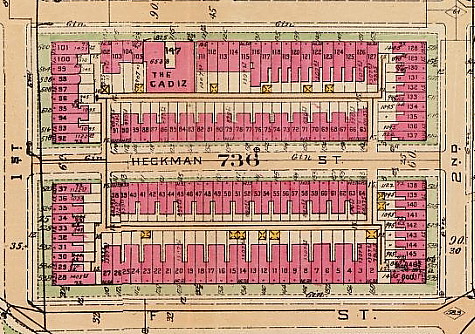 My research often begins with an old map, on which I notice something that no longer has a place on the Hill. Usually, it is a building of some sort that catches my attention. Sometimes, it’s a name such as Heckman Street on a 1921 map. Who was Heckman, I wondered, and why was his or her name on this map? In 1886, Daniel Carroll of Duddington’s heirs sold Duddington, the mansion that he had built in the earliest days of the Federal City. While it had served him and his family well, it was now sadly outdated, possibly ghost-ridden, and no longer the grand house it had once been. The new buyers thus tore it down, and began casting about for an appropriate substitute. Duddington had stood on a full square, bounded by 1st, 2nd, E and F Streets, Southeast, and was thus a valuable piece of property.
My research often begins with an old map, on which I notice something that no longer has a place on the Hill. Usually, it is a building of some sort that catches my attention. Sometimes, it’s a name such as Heckman Street on a 1921 map. Who was Heckman, I wondered, and why was his or her name on this map? In 1886, Daniel Carroll of Duddington’s heirs sold Duddington, the mansion that he had built in the earliest days of the Federal City. While it had served him and his family well, it was now sadly outdated, possibly ghost-ridden, and no longer the grand house it had once been. The new buyers thus tore it down, and began casting about for an appropriate substitute. Duddington had stood on a full square, bounded by 1st, 2nd, E and F Streets, Southeast, and was thus a valuable piece of property.
In spite of its value, it would take a number of years for a suitable replacement to be found. In 1894, a W. Riley Deeble, who was “owner in trust” of Square 736, on which Duddington had stood, wrote a long letter to the Washington Post, which they published on their front page under the heading “Practical Suggestions by a Well-known Citizen.” In the letter, Deeble offered his land as a suitable place for the new Publich Printing Office, as it was close to Congress, and well-connected to railroads. Furthermore, the other sites being looked at were in particularly disease-ridden sections of town, while his square was “situated in one of the healthiest portions of the city.” In spite of Deeble’s sales pitch, and the Post’s apparent support for it, nothing came of the sale. The PPO was built on North Capitol Street, where it remains today. Deeble – and further owners of the land – hardly had reason to complain. In the next couple of years, the city laid sewer under this square, and then asphalted the street, so that sales of the lots – and houses built on the lots – could proceed apace. In 1895, the square began to be referred to as “Heckman’s subdivision.” Sadly, there is no indication of who or what it might be named for. Nonetheless, the street which was put in from 1st to 2nd Street was given this name, as well, and thus for the next 65 years, Heckman Street appears frequently in the news.
Given that it was a small street, lined with small houses, the usual tenants were poor, a fact reflected in the ways that they were came to be mentioned in the papers. Though sometimes it was a son who had made good in the Navy, and occasionally an amusing anecdote of a youngster who sold fraudulent newspaper subscriptions to well-meaning congressmen and their secretaries, the usual reason for a few lines in the papers was death, robbery, or assault. While the street was populated mainly with working-class whites until the first world war, this changed almost completely by the early 1920s, and the street would remain almost uniformly African American until the 1970s. During this time, none other than Elgin Baylor, basketball standout at Spingarn High School before a long career with the Lakers, both in Minneapolis and Los Angeles, was a resident here.
In 1960, it was decided that the name Heckman had no particular meaning, and the street should thus be renamed. The new name? Duddington Place, a throwback to the original mansion on the square, and the man who had built it in the earliest days of Washington D.C. As such, it remains home to a row of small, but well-loved houses just a few blocks from the Capitol.

